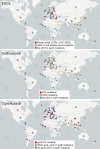Using genomics to understand antimicrobial resistance and transmission in Neisseria gonorrhoeae
- PMID: 30698520
- PMCID: PMC6421347
- DOI: 10.1099/mgen.0.000239
Using genomics to understand antimicrobial resistance and transmission in Neisseria gonorrhoeae
Abstract
Gonorrhoea infections are on the increase and strains that are resistant to all antimicrobials used to treat the disease have been found worldwide. These observations encouraged the World Health Organization to include Neisseria gonorrhoeae on their list of high-priority organisms in need of new treatments. Fortunately, concurrent resistance to both antimicrobials used in dual therapy is still rare. The fight against antimicrobial resistance (AMR) must begin from an understanding of how it evolves and spreads in sexual networks. Genome-based analyses have allowed the study of the gonococcal population dynamics and transmission, giving a novel perspective on AMR gonorrhoea. Here, we will review past, present and future treatment options for gonorrhoea and explain how genomics is helping to increase our understanding of the changing AMR and transmission landscape. This article contains data hosted by Microreact.
Keywords: antimicrobial resistance; genomics; gonorrhoea; sexual networks; transmission.
Conflict of interest statement
The authors declare that that there are no conflicts of interest.
Figures

Similar articles
-
Genomic analyses of Neisseria gonorrhoeae reveal an association of the gonococcal genetic island with antimicrobial resistance.J Infect. 2016 Dec;73(6):578-587. doi: 10.1016/j.jinf.2016.08.010. Epub 2016 Aug 26. J Infect. 2016. PMID: 27575582 Free PMC article.
-
Antimicrobial resistance and Neisseria gonorrhoeae multiantigen sequence typing (NG-MAST) genotypes in N. gonorrhoeae during 2012-2014 in Karachi, Pakistan.BMC Infect Dis. 2016 Jul 22;16:353. doi: 10.1186/s12879-016-1673-1. BMC Infect Dis. 2016. PMID: 27449234 Free PMC article.
-
Antimicrobial Resistance in Neisseria gonorrhoeae and Treatment of Gonorrhea.Methods Mol Biol. 2019;1997:37-58. doi: 10.1007/978-1-4939-9496-0_3. Methods Mol Biol. 2019. PMID: 31119616
-
Current and future antimicrobial treatment of gonorrhoea - the rapidly evolving Neisseria gonorrhoeae continues to challenge.BMC Infect Dis. 2015 Aug 21;15:364. doi: 10.1186/s12879-015-1029-2. BMC Infect Dis. 2015. PMID: 26293005 Free PMC article. Review.
-
The continuing evolution of antibiotic resistance in Neisseria gonorrhoeae: past, present and future threats to effective treatment.J Antimicrob Chemother. 2025 May 2;80(5):1213-1219. doi: 10.1093/jac/dkaf109. J Antimicrob Chemother. 2025. PMID: 40205910 Review.
Cited by
-
One is not enough: On the effects of reference genome for the mapping and subsequent analyses of short-reads.PLoS Comput Biol. 2021 Jan 27;17(1):e1008678. doi: 10.1371/journal.pcbi.1008678. eCollection 2021 Jan. PLoS Comput Biol. 2021. PMID: 33503026 Free PMC article.
-
Vaccines Against Antimicrobial Resistance.Front Immunol. 2020 Jun 3;11:1048. doi: 10.3389/fimmu.2020.01048. eCollection 2020. Front Immunol. 2020. PMID: 32582169 Free PMC article. Review.
-
[Establishment and Evaluation of a Resazurin-Based Microdilution Assay for Microbial Sensitivity Test of Neisseria gonorrhoeae].Sichuan Da Xue Xue Bao Yi Xue Ban. 2024 Jan 20;55(1):198-203. doi: 10.12182/20240160209. Sichuan Da Xue Xue Bao Yi Xue Ban. 2024. PMID: 38322510 Free PMC article. Chinese.
-
Neisseria gonorrhoeae clustering to reveal major European whole-genome-sequencing-based genogroups in association with antimicrobial resistance.Microb Genom. 2021 Feb;7(2):000481. doi: 10.1099/mgen.0.000481. Microb Genom. 2021. PMID: 33245688 Free PMC article.
-
Review on Multiple Facets of Drug Resistance: A Rising Challenge in the 21st Century.J Xenobiot. 2021 Dec 13;11(4):197-214. doi: 10.3390/jox11040013. J Xenobiot. 2021. PMID: 34940513 Free PMC article. Review.
References
-
- Newman L, Rowley J, vander Hoorn S, Wijesooriya NS, Unemo M, et al. Global estimates of the prevalence and incidence of four curable sexually transmitted infections in 2012 based on systematic review and global reporting. PLoS One. 2015;10:e0143304. doi: 10.1371/journal.pone.0143304. - DOI - PMC - PubMed
-
- GBD 2016 Disease and Injury Incidence and Prevalence Collaborators Global, regional, and national incidence, prevalence, and years lived with disability for 328 diseases and injuries for 195 countries, 1990-2016: a systematic analysis for the Global Burden of Disease Study 2016. Lancet. 2017;390:1211–1259. doi: 10.1016/S0140-6736(17)32154-2. - DOI - PMC - PubMed
-
- Town K, Obi C, Quaye N, Chisholm S, Hughes G, GRASP Collaborative Group Drifting towards ceftriaxone treatment failure in gonorrhoea: risk factor analysis of data from the gonococcal resistance to antimicrobials surveillance programme in England and Wales. Sex Transm Infect. 2017;93:39–45. doi: 10.1136/sextrans-2016-052583. - DOI - PubMed
Publication types
MeSH terms
Substances
Grants and funding
LinkOut - more resources
Full Text Sources
Medical
Miscellaneous

